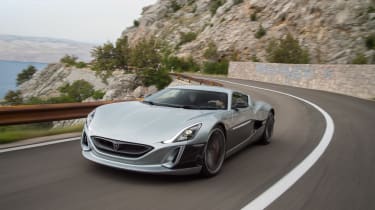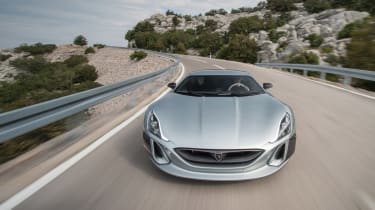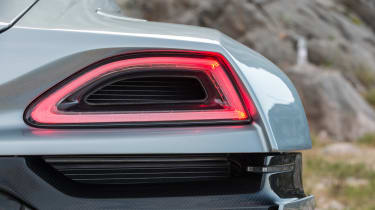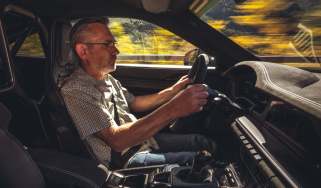Rimac Automobili Concept One review - electric hypercar driven
All-electric supercar proves EVs can be spectacular to drive
The world's first electric supercar? If anything can stake a claim to this accolade, it's the Rimac Automobili Concept One. Based on the outskirts of Zagreb in Croatia and controlled by founder Mate Rimac, his eponymous company isn't exactly a household name yet, and its car - the Concept One - is limited to just eight examples.
But Rimac is more than just a supercar manufacturer. Behind the scenes it's been quietly establishing itself as a supplier of electric drivetrains, working closely with major car manufacturers. It also applies its expertise to everything from bikes to boats. It's this strong brand-building which has enabled Rimac to build the Concept One.
Engine, transmission and 0-60 time
The Concept One uses four electric motors, one driving each wheel, with batteries mounted along the spine of the car and behind the rear bulkhead. Open the rear hatch and you’ll see a power distribution unit where you’d expect to see the engine in a mid-engined car.
Between them the motors generate a colossal 1073bhp and 1180lb ft of torque. The 0-62mph time is just 2.6 seconds, while the top speed is 221mph. Rimac claims a range of 200 miles in more sedate driving.
Being all-electric the Concept One doesn’t use a conventional transmission. However, in order to achieve the lowest possible 0-62mph time, it does feature two very small dual-clutch, two speed gearboxes within the rear axle. The shorter ratio gives maximum acceleration and runs up to around 100mph, but owners will be encouraged to leave their cars in the longer ratio most of the time.
More reviews
Group tests
- Lotus Emira Turbo SE v Alpine A110 GTS – two of the last surviving mid-engined sports cars
- Alpine A290 v Alpine A110 – how much DNA do they really share?
- Ariel Atom 4R v Caterham Seven ‘evo25’: power-to-weight heroes go head-to-head
- Ariel Atom 4 v Caterham Seven 310R v Lotus Elise Cup 250
- £200,000 supercar shoot-out: AMG v Aston Martin v Maserati v McLaren
- Audi Quattro, RS2 and RS3: five-cylinder icons head-to-head
- Who makes the best GT car? Aston Martin v Bentley v Maserati
- Caterham Super Seven 600 v Super Seven 2000
- Corvette Stingray v Porsche Cayman GTS v Audi R8 RWD
- Great Ferrari hypercars driven: 288 GTO, F40, F50 and Enzo head-to-head
In-depth reviews
- Abarth 600e 2025 review – Italy gives the Alpine A290 something to worry about
- Alpine A110 review – the sports car Lotus should be building
- Aston Martin Vantage 2025 review – a thrilling Mercedes-AMG GT and 911 Turbo S alternative
- Audi R8 (2015 - 2024) review – the ultimate soft-focus supercar
- Bentley Flying Spur review – the ultimate driver’s limousine
Long term tests
- Abarth 695C Turismo Fast Fleet test – living with the charming Italian hatch
- Alfa Romeo Giulia Veloce long term test – can Italy beat Germany?
- Aston Martin Vantage (2006) Fast Fleet test – living with a £30k V8 Aston
- Caterham Seven evo25 Fast Fleet test – living with a track car for the road
- Caterham Seven evo Edition revealed – bespoke 420R joins the Fast Fleet
- Cupra Leon 300 Fast Fleet test – living with Spain's 300bhp hot hatch
- Cupra Ateca VZN Fast Fleet test – four months with Cupra's hot crossover
- Cupra Leon Estate 310 4Drive Fast Fleet test – living with the 306bhp hot estate
- Ford Mustang GT
- Ford Mustang GT
Review
- New Bentley Batur 2023 review – can it possibly be worth £1.65m?
- 2023 Chevrolet Corvette C8 Z06 review – the American 911 GT3?
- BBR Supercharged Mazda MX-5 (ND) 2023 review – tuned 250bhp roadster driven
- MG4 Trophy 2023 review
Reviews
- Abarth 695 75 Anniversario edition 2024 review – a fitting send-off for Abarth’s hot supermini?
- Abarth 500e 2023 review
- AC Cobra 378 Superblower MkIV 2021 review – another V8 Cobra, but with a GM heart this time
- Acura Integra Type S 2024 review – a Honda Civic Type R with added restraint
- Alfa Romeo Giulia review – get one while you still can
- Alfa Romeo 33 Stradale 2025 review – a rare Italian jewel beyond compare
- Alfa Romeo SZ: history, review and specs of an icon
Most modern high performance cars feature some sort of torque vectoring system, but none are as technologically advanced as the Concept One’s Rimac All-Wheel Torque Vectoring. The four electric motors can be precisely controlled to deliver a range of dynamic behaviour – be it stable on road manners or ultra-agile high performance track driving. There’ll also be a drift mode in the near future.
Technical highlights
Featuring dozens of Rimac Automobili patents the Concept One is among the most technologically advanced supercars on sale. The drivetrain is undoubtedly the car’s centerpiece and every component within it has been designed and manufactured by Rimac itself.
In fact, the only major off-the-shelf components anywhere on the car are the Brembo brakes and KW suspension. Even the headlights and infotainment system are Rimac’s own designs.
The car is built around a spaceframe chassis with double wishbone suspension and pushrods all round. The steering is hydraulically assisted – electric assistance would have been more efficient but it didn’t give the steering feel the engineers wanted – and the tyres are Pirelli P Zeros.
What’s it like to drive?
The first thing you notice when you drop into the Concept One’s cabin is the headroom, or lack thereof. Anybody over 5ft10 will feel very cramped inside the cabin, while six footers will have to slouch heavily in the bucket seat just to find enough headroom to drive the car.
The cabin itself is attractively designed and the quality is mostly good, albeit with a distinct low-volume, hand-built feel. The infotainment system, meanwhile, is very clear and easy to navigate.
The steering is heavy in its default mode – there is a lighter setting – but it’s feelsome and direct with an immediate, slack-free rate of response at the front axle. There’s tension to the ride quality that works just fine on smoother roads, but on rougher sections the car does feel busy and unsettled.
With 250lb ft of torque being deployed through each front wheel the car has a habit of dragging itself across the road, too, but only on bumpier sections does it ever become an irritation.
One of the car’s major dynamic weaknesses relates to its braking system – or more accurately, its three braking systems. The first is the kinetic energy recovery, which slows the car significantly when you lift off the throttle so you can ‘one pedal drive’ around town. The second system is the regenerative braking, which inverts the motors when you stand on the brake pedal to recharge the batteries, and the third is the conventional brake system, which uses carbon ceramic discs and six-piston calipers.
The kinetic energy recovery system can be turned right down, which is useful because it tends to disrupt your rhythm on a quick run. The bigger issue, though, is that marrying all three braking systems together to give a progressive, feelsome and predictable brake pedal is close to impossible. As a result the Concept One can be a tricky car to have faith in when braking for a corner.
Under acceleration, however, the Concept One is remarkable. With so much torque available immediately it pulls phenomenally hard, without hesitation, and it actually accelerates with more force the longer you keep your foot in.
And then there’s the torque vectoring. The electronic super brain diverts more torque to the outside wheels than the inner wheels in the way into a corner, and actually applies negative torque – effectively a braking input – to the inside rear. This pivots the car into the corner and makes it feel incredibly agile.
The computer then favours the outside rear wheel for maximum drive out of the corner. The Concept One feels incredibly positive away from corners with no hint of under or oversteer, even if you apply full throttle much earlier than you think should be possible. That gives the car staggering pace on the road.
The Concept One does lack the soundtrack and the dramatic power delivery of a conventional supercar, but in the way it accelerates and in the way its torque vectoring system picks apart a corner it is enormously entertaining to drive quickly.
During our test drive the car did shut itself down on a number of occasions, which required a quick reset by the technicians. This is likely to be little more than a teething issue, but it’s the reason the Concept One scores three and a half stars rather than four for the time being.
Price and rivals
At the best part of £1m after taxes the Concept One sits squarely in the same hypercar category as the McLaren P1 and Porsche 918 Spyder. It has the straight line performance to live with that company – in fact Rimac has released a video of the Concept One out-dragging a LaFerrari – but it’s unlikely to match those more conventional hypercars for lap time because it lacks downforce and outright mechanical grip.






